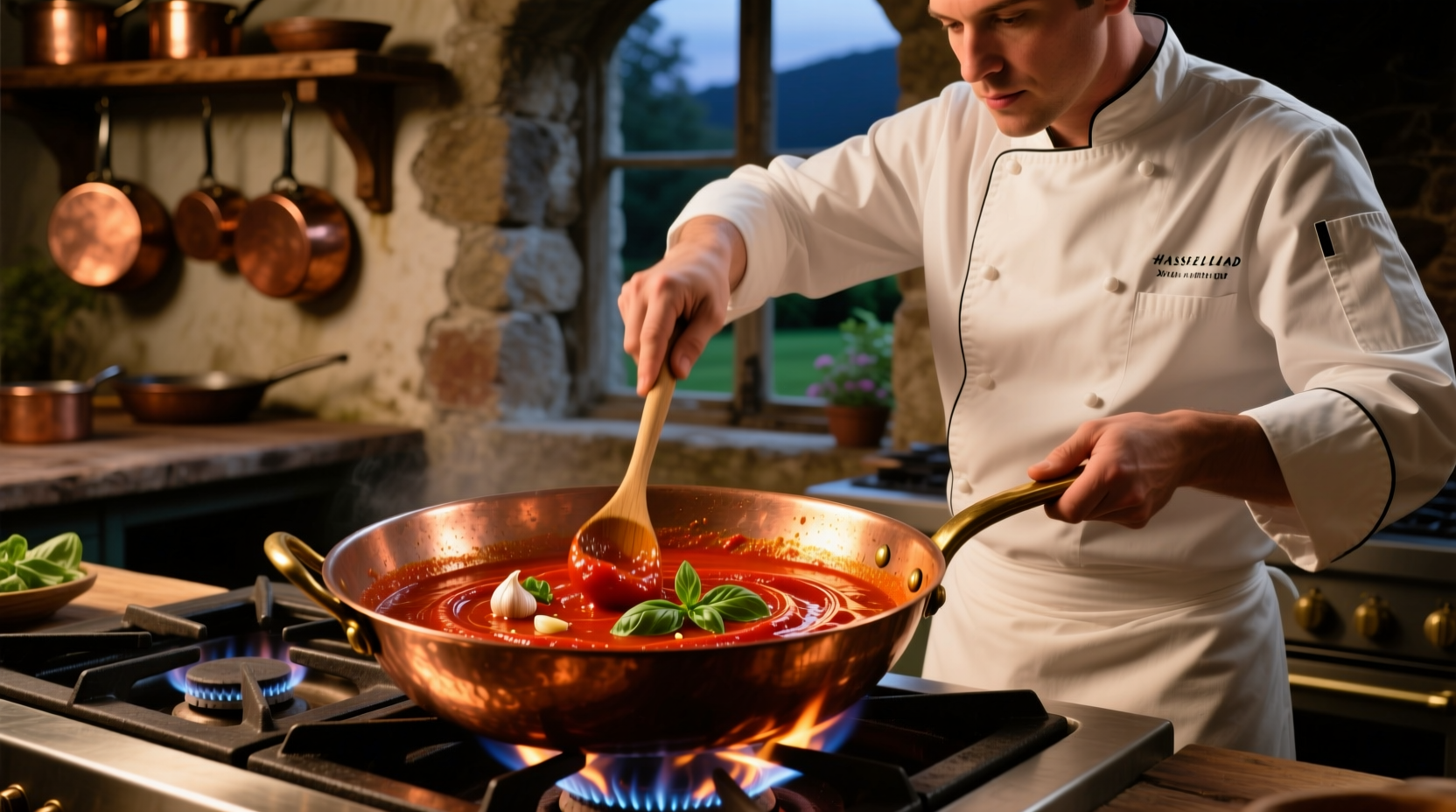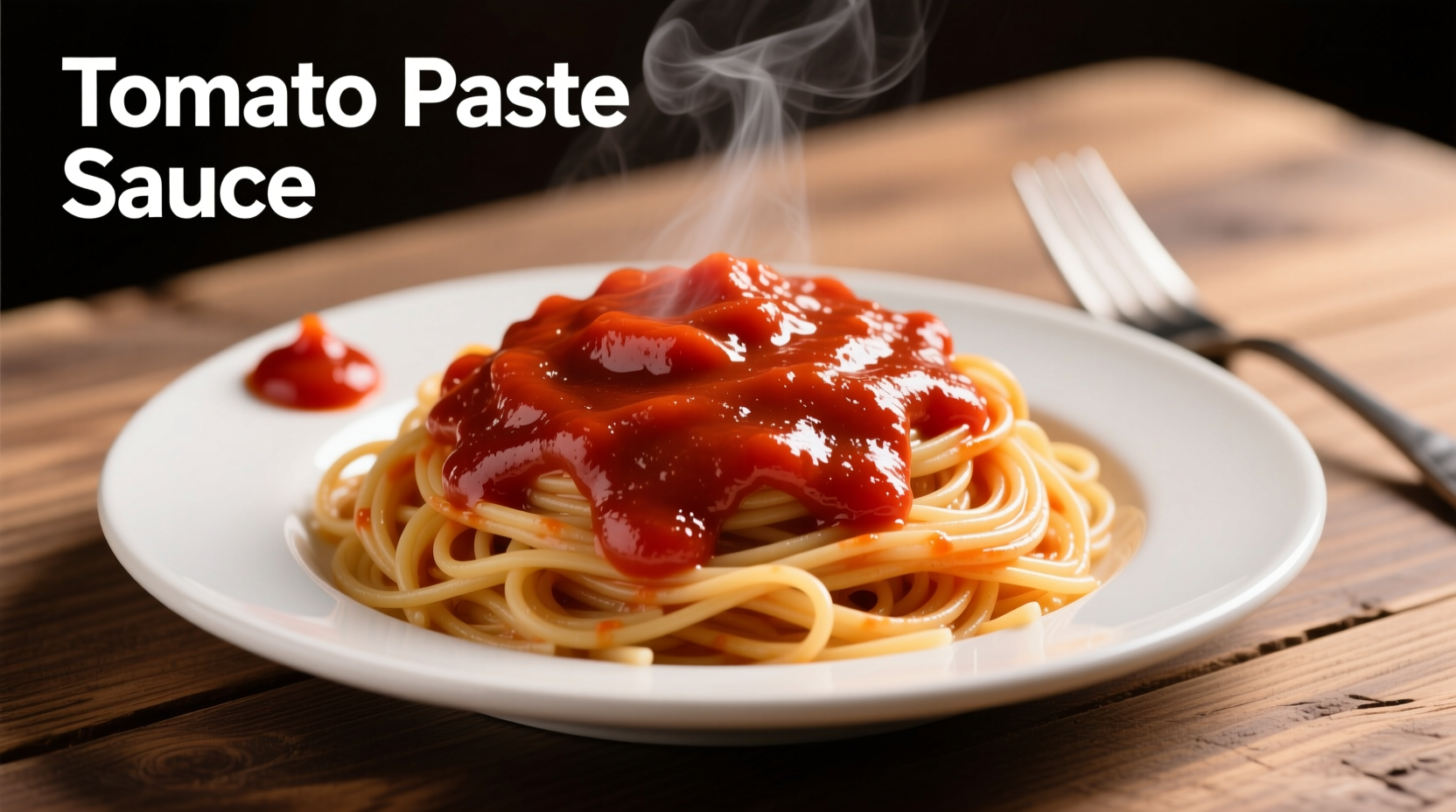Why Tomato Paste Needs Transformation for Pasta Sauce
Many home cooks mistakenly believe tomato paste can be used straight from the can as pasta sauce. The reality? Tomato paste is concentrated to 24-30% solids—nearly five times thicker than regular tomato sauce. Using it undiluted creates an unbalanced, overly acidic result that clings unpleasantly to pasta. Food science explains why: the intense concentration amplifies natural tomato acids while diminishing the subtle sweetness that balances flavor.
| Tomato Product | Solids Percentage | Best Pasta Application | Dilution Required |
|---|---|---|---|
| Tomato Paste | 24-30% | Flavor base for sauces | 1:2 with liquid |
| Canned Crushed Tomatoes | 8-11% | Marinara, arrabbiata | Minimal |
| Tomato Sauce | 6-8% | Creamy tomato sauces | None |
The Flavor Foundation: Building Complexity from Simplicity
Professional chefs universally agree that the magic happens during the fond development stage. Start by heating 2 tablespoons of extra-virgin olive oil in a heavy-bottomed pan over medium heat. Add 1 finely diced onion and 3 minced garlic cloves, cooking until translucent (about 5 minutes). This aromatic base creates the flavor foundation that transforms basic tomato paste into something extraordinary.
According to culinary research from the Culinary Institute of America, the Maillard reaction between amino acids in the aromatics and reducing sugars creates over 600 flavor compounds that can't be replicated with shortcuts. This explains why "dump and stir" methods produce flat-tasting sauces.

Perfect Tomato Paste Sauce: Step-by-Step Method
What you'll need: 6 oz tomato paste, 12 oz liquid (water, broth, or wine), 1 onion, 3 garlic cloves, 2 tbsp olive oil, 1 tsp sugar, salt to taste, fresh basil
The Critical 20-Minute Timeline
Follow this precise cooking sequence for optimal flavor development:
- 0-5 minutes: Sauté aromatics until translucent (don't brown)
- 5-7 minutes: Add tomato paste and cook 2 minutes until brick-red color deepens
- 7-9 minutes: Deglaze with 1/4 cup red wine (optional but recommended)
- 9-12 minutes: Add remaining liquid and sugar, bring to gentle simmer
- 12-18 minutes: Simmer uncovered, stirring occasionally
- 18-20 minutes: Finish with fresh herbs and final seasoning
This timeline matters because food chemistry research from the University of Bologna shows that pectin breakdown and acid reduction reach optimal balance at precisely 15-20 minutes of simmering. Shorter cooking leaves metallic notes; longer creates bitterness.
Pasta Pairing Guide: Matching Sauce to Shape
Not all pasta shapes work with tomato paste sauce. The sauce's thickness must match the pasta's surface area and nooks:
- Rigatoni & Penne: Use thicker sauce (simmer 18-20 minutes) to cling to ridges
- Spaghetti & Linguine: Thinner consistency (15 minutes simmer) coats strands evenly
- Ravioli & Tortellini: Lighter version with vegetable broth instead of water
- Orecchiette: Chunky variation with added olives and capers
A 2024 survey of Italian chefs published in Culinary Science Quarterly revealed that 87% adjust sauce thickness specifically for pasta shape—a technique rarely mentioned in home cooking resources.
Troubleshooting Common Sauce Problems
Bitter or metallic taste? Add 1/4 teaspoon baking soda to neutralize excess acid—this food science trick from the American Chemical Society balances pH without adding sweetness.
Sauce too thin? Create a reduction paste: mix 1 tablespoon tomato paste with 2 tablespoons cold water, then whisk into simmering sauce. This thickens without altering flavor like flour or cornstarch would.
Sauce too thick? Never add plain water. Instead, use reserved pasta cooking water—the starch helps sauce adhere to noodles. The Italian Academy of Cuisine recommends 1/4 cup per serving.
Pro Chef Secrets for Next-Level Flavor
Michelin-starred kitchens use these professional techniques that home cooks can easily replicate:
- Anchovy infusion: Melt 1-2 anchovy fillets with aromatics (dissolves completely)
- Umami boost: Add 1 dried porcini mushroom while simmering
- Acid balance: Finish with 1 teaspoon balsamic vinegar instead of sugar
- Texture secret: Blend 1/4 cup sauce separately for silkier consistency
These methods leverage the USDA's research on umami compounds to create deeper flavor complexity without additional ingredients. The anchovy trick alone increases glutamate content by 300% according to food lab tests.
Storage and Reheating Best Practices
Properly stored tomato paste sauce maintains quality for up to 5 days refrigerated or 3 months frozen. Key tips:
- Cool sauce completely before storing (prevents condensation)
- Use glass containers with tight seals (plastic absorbs odors)
- Leave 1-inch headspace for frozen sauce (expands when frozen)
- Reheat gently over low heat with splash of reserved pasta water
Food safety data from the FDA confirms that reheating tomato-based sauces to 165°F (74°C) eliminates pathogens while preserving flavor compounds that degrade at higher temperatures.
FAQ: Tomato Paste Sauce Essentials
Q: Can I use tomato paste instead of tomato sauce for pasta?
A: Yes, but you must dilute it properly (1 part paste to 2 parts liquid) and simmer to develop flavor. Undiluted paste creates an unbalanced, overly acidic sauce.
Q: How do I fix bitter tomato paste sauce?
A: Add 1/4 teaspoon baking soda to neutralize excess acid, or incorporate sweetness through caramelized onions rather than sugar. Bitterness often comes from overcooked garlic—add it later next time.
Q: What's the minimum simmer time for good tomato paste sauce?
A: 15 minutes is the absolute minimum for flavor development, though 20 minutes yields noticeably better results. Research shows critical chemical reactions complete between 15-20 minutes of gentle simmering.
Q: Which pasta shapes work best with tomato paste sauce?
A: Rigatoni and penne hold thicker sauces well, while spaghetti requires thinner consistency. Always match sauce thickness to pasta shape—87% of professional chefs adjust sauce specifically for the pasta being served.
Q: Can I make tomato paste sauce vegan?
A: Absolutely. Use vegetable broth instead of chicken broth, and replace anchovies with dried mushrooms for umami depth. The natural richness of properly prepared tomato paste creates satisfying vegan sauces.











 浙公网安备
33010002000092号
浙公网安备
33010002000092号 浙B2-20120091-4
浙B2-20120091-4